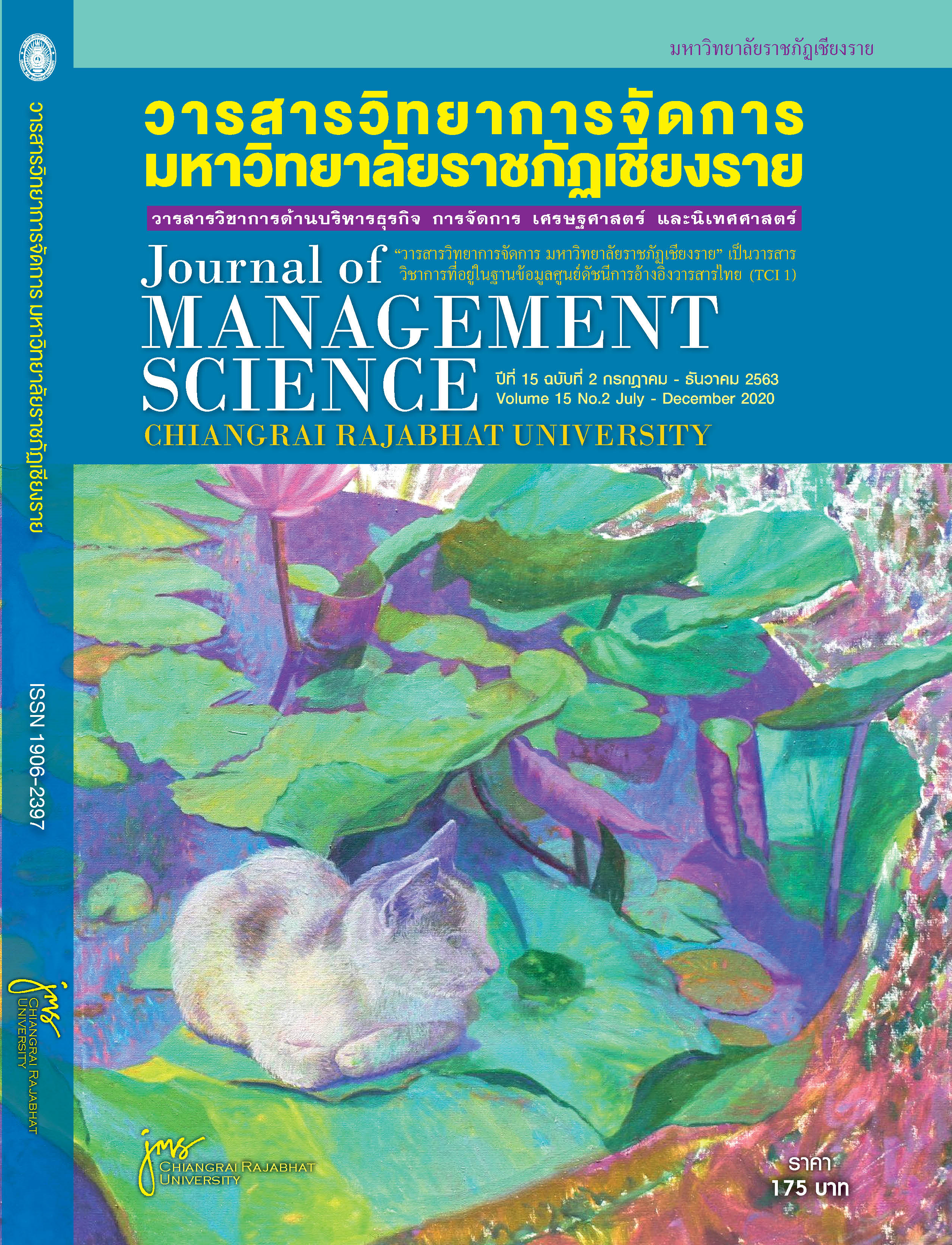Myths and the Changing Paradigm of Mommy’s Powdered Milk in Bangkok
Main Article Content
Abstract
This research, Myths and the Changing Paradigm of Mommy’s Powdered Milk in Bangkok, aimed to explore the mystery of mother’s powdered milk and to study the potential changes in mother’s powdered milk in Bangkok. It used qualitative research methods in the form of focus group discussion. The in-depth interviews were conducted with a group of 40 females with the age of 15-40 years. The purposive samples were divided into 5 groups of 8-12 persons, which included 1) low income group 2) medium income group 3) high income group 4) housewife group and 5) working group. The results found that the first image the mother saw, the first symbol the mother saw, and the word or phrase the mother would say the most when referring to the word “powdered milk’ came from the activities of the whole milk company. Moreover, it was found that the sample opinions on the comparison between powdered milk and breast milk were “powdered milk contains no nutrients equal to breast milk”, “powdered milk is not good as breast milk”, and “powdered milk is not equivalent to breast milk”. However, more than half of the sample commented that “powdered milk can replace breast milk” and “powdered milk can be used with breast milk” as well. Furthermore, the results showed that the change in the myths of powdered milk led to the definition of “powdered milk = risk”, which keep in mother’s mind to score more than 8 is quite difficult or did not know how many years to change this idea. The reason is because there is no proof to confirm why the mother still needs powdered milk to raise the baby, why baby still drinks powdered milk without problems, and the reason that if the consumption of powdered milk is at risk, there is no production to sell.
Article Details
Views and opinions expressed in the journal do not necessarily reflect those of the editors.
References
Aphikulchatkit, Yodkwan. (2018). Compared growth of term breast-fed infants and term formula-fed infants in
police general hospital. JOPN. 10 (1), 93-99. (In Thai).
Bangkra, Sakun. (2014). Formula for Powder-milk Mixing with Myth. Retrieved August 21, 2014, from
http://www.bangkokbiznews.com/news/detail/599793 (In Thai).
Barthes, R. & Lavers, A. (1991). Mythologies. New York : The Noonday Press.
Cetthakrikul, Nisachol & Tupsart, Kitiporn. (2019). When, Why and What Factors of Initiating Breast Milk
Substitutes in the First 6 Months. Journal of Health Systems Research. 13(2), 220-233. (In Thai).
Charoensin-o-larn, Chairat. (2008). Language and Politics / Politics. Bangkok : Printing Factory
Thammasat University. (In Thai).
Chiadamrong, Bavonsan. (2016). A Surveillance and Monitoring of Marketing Communication in Promoting the
Powdered Milk Products that Violate the International Code during the Push for the Enactment of the Draft Marketing of Infant and Young Child Food and Related Products Act in Thailand. Rom Phruek Journal Krirk University. 34 (2), 105-124. (In Thai).
Department of Health. (2017). Control of Marketing Promotion of Infant and Young Child Food Act, B.E.
(2017). Retrieved April 28, 2020, from http://www.laws.anamai.moph.go.th/more_news.php?
cid=430tfilename=milkcode_01_05 (In Thai).
Department of Health. (2018). "Breast milk" authentic benefits from nature. Retrieved April 24, 2020, from
http://multimedia.anamai.moph.go.th/help-knowledgs/benefits-of-breastfeeding/ (In Thai).
Government, Gazette. (2019). Labor protection act (no.7) B.E.2562 (2019). Retrieved April 28, 2020, from
http://www.ratchakitcha.soc.go.th/data/ppf/2562/A/043 (In Thai).
Jaichuen, Nongnuch & Phakdeesettakun, Kannapon. (2015). The Exposure of Marketing Communication on Thai
Women’s Breast Milk Substitutes Behavior. Journal of Communication Arts. 33(4), 121-133.
(In Thai).
Kaewthep, Kanchana. (1993). Curtain of Prejudice: The Relationship between Woman and Social Institutions.
Pathum Thani : Gender Press Publisher. (In Thai).
Kaewthep, Kanchana. (2001). The Science of Media and Cultural Studies. Bangkok : Edison Press
Products Co., Ltd. (In Thai).
Kaewthep, Kanchana. (2010). New Approach to Communicative Education. Bangkok : Graphic Arts Limited
Partnership. (In Thai).
Kaewthep, Kanchana & Hinviman, Somsuk. (2008). The Stream of Thinkers Political Economy and
Communication Education. Bangkok : Graphic Arts Limited Partnership. (In Thai).
Kanpai, Kitti & Chiadamrong, Bavonsan. (2013). Marketing Communication Strategy of Powder-milk
Companies and Code Violations. Bangkok : United Nations Children's Fund-UNICEF. (In Thai).
National News Bureau of Thailand. (2018). Department of Health reveals online market breaking illegal
milk powder Continue to condone the act regulating the promotion of food marketing for infants
and young children 2017, violating a fine of up to 300,000 baht. Retrieved April 29, 2020, from http://www.thainews.prd.go.th/th/news/detail/TCATG191010152743465 (In Thai).
National Statistical Office. (2013). Major Findings of Children and Women Situation in Thailand 2012
(MICS 4). Bangkok : Text and journal Publication., Ltd. (In Thai).
Nualcham, Penrung, et al. (2013). Factors affected to behavior and during time for breastfeeding of Pasi
Charoen persons. Retrieved August 15, 2014, from http://rcfcd.com/?p=2121 (In Thai).
Padthong, Pornthida, Tiptaradol, Siriwat & Hangchaowanich, Yupayong. (2013). The law on marketing of
Infants and young child . Retrieved August 14, 2014, from https://library.thaibf.com/handle/ 023548404.11/395 (In Thai).
Plaichum, Siritorn, Tongswas, Tiamsorn & Somboon, Lawan. (2012). Factors Related to Breastfeeding Duration
among Adolescent Mothers. Nursing Journal. 39(2), 79-87. (In Thai).
Prutipinyo, Chardsumon. (2017). Trade and Health: A control regulation on marketing promotion for infants and
young children’s food and related products. Public Health & Health Laws Journal. 3(1), 88-102.
(In Thai).
Sinsuksai, Nittaya, Yusamran, Chaweewan & Phupaibul, Rutja. (2014). Breastfeeding Behaviour in a Suburban
Community. Thai Journal of Nursing Council. 29(3), 69-79. (In Thai).


